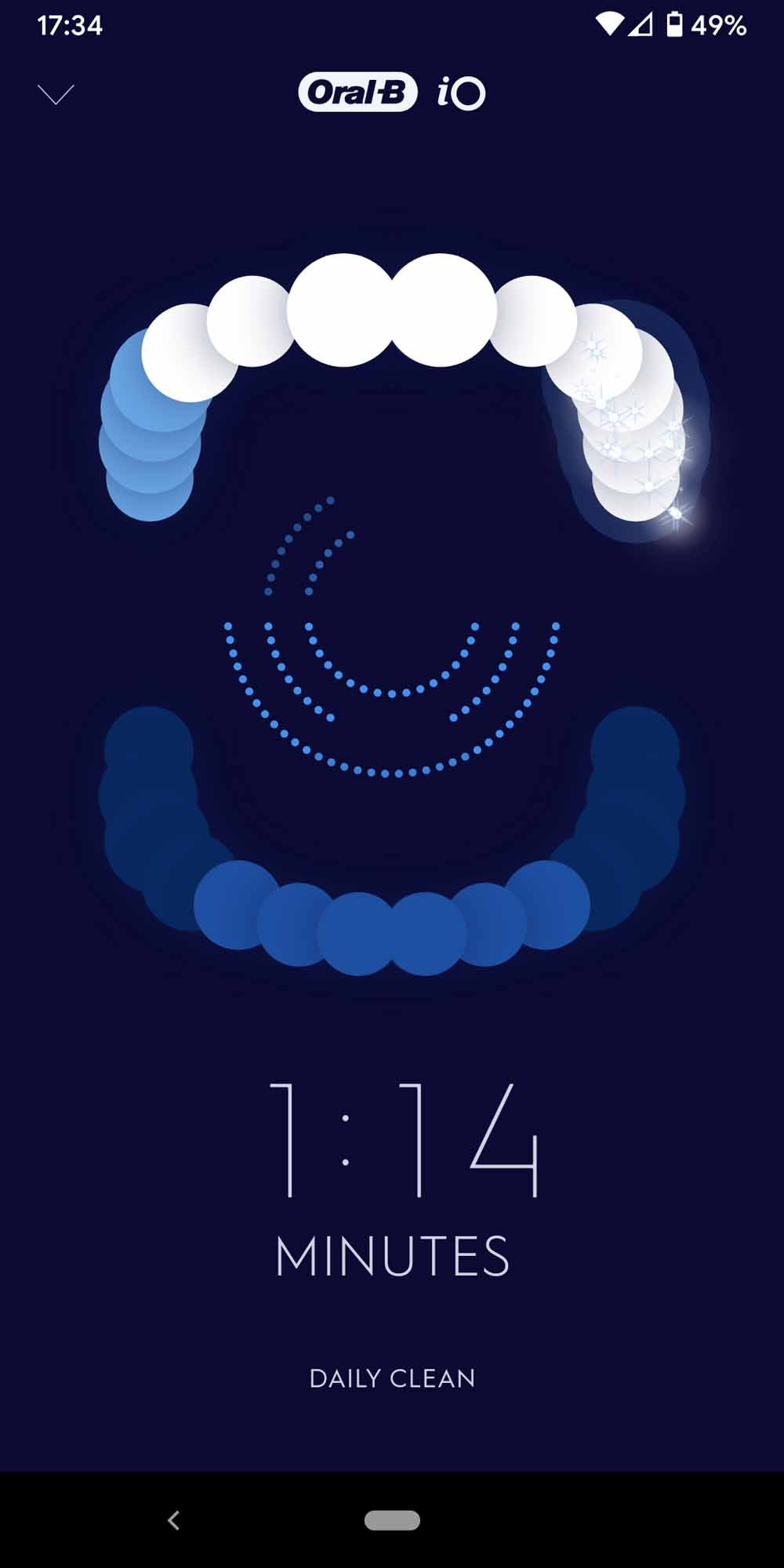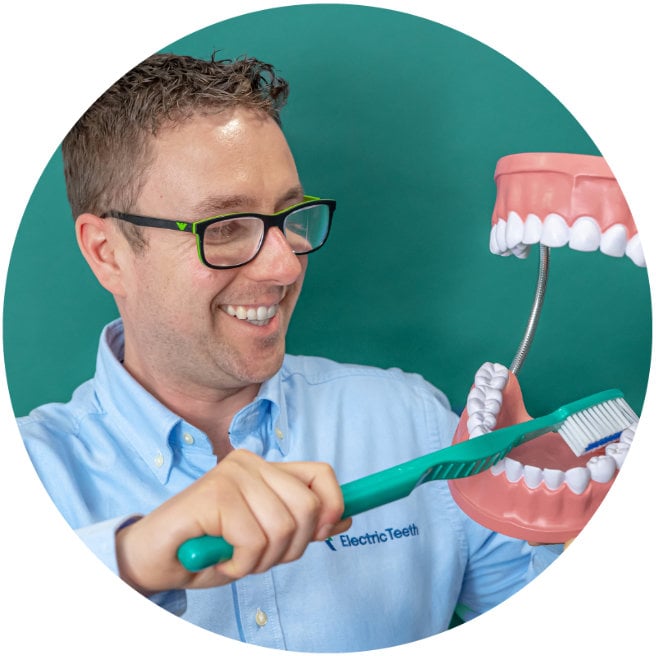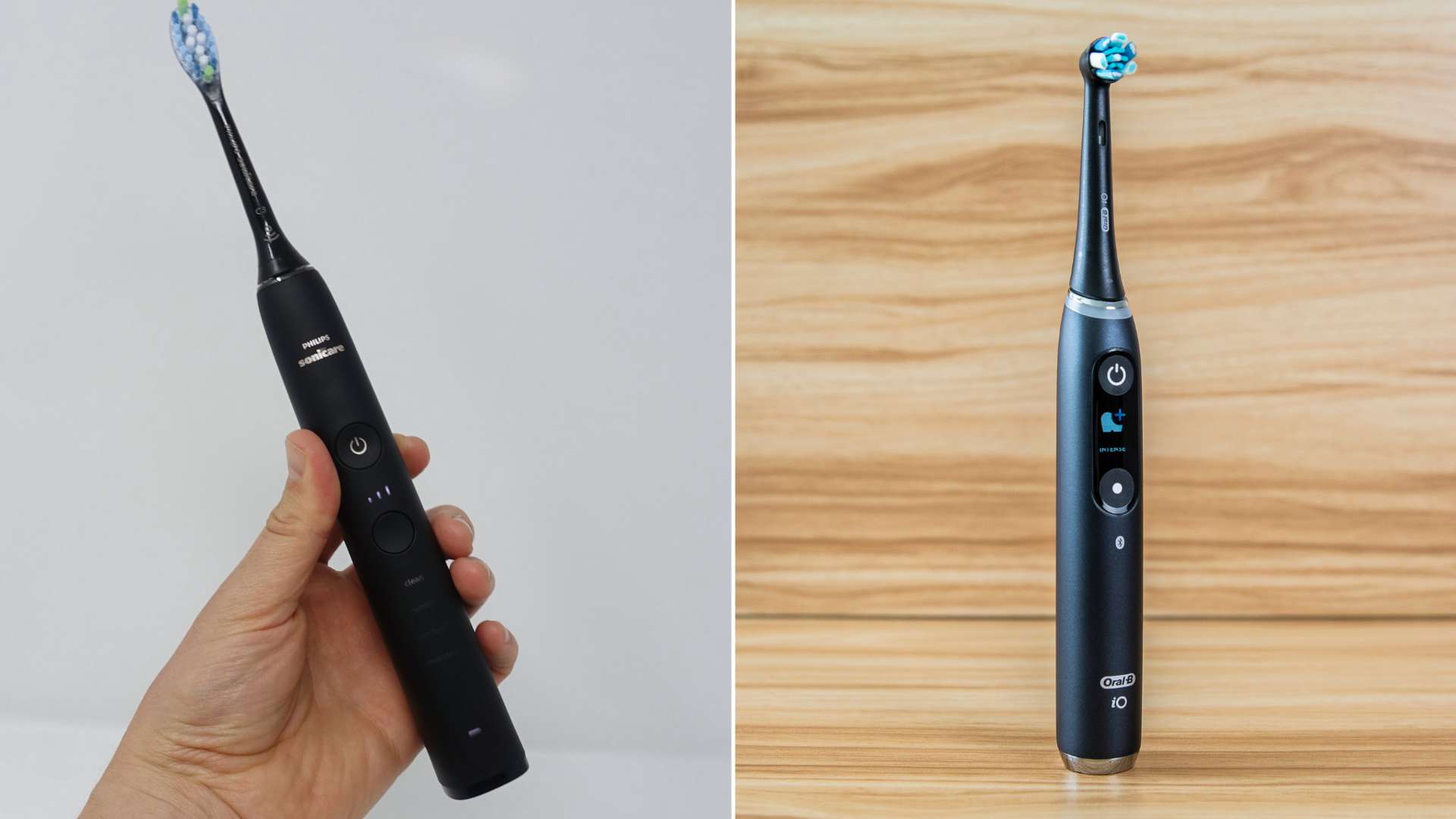
The video compares the UK version of the DiamondClean 9000 and iO. There are subtle differences. But the general message is the same.
Which one would we choose?
Our choice: Oral-B iO Series 9 (iO9) / Shaver Shop / ~$749
2nd choice: Philips Sonicare DiamondClean 9000 / Amazon, Shaver Shop / ~$399
Despite having the more expensive price tag the Oral-B iO is our choice between these 2 premium toothbrushes.
The iO offers a more rounded package and better smart features.
There are certain refinements that still make the DiamondClean 9000 very appealing, but you can do better for the money.
Key differences
| Find out more |
| Electric Teeth Rating |
| Retail price |
| Approximate 3 year cost |
| Cleaning Action |
| Number of cleaning modes |
| Brushing intensities |
| Timer |
| Pacer |
| Pressure Sensor |
| Battery life |
| Battery type |
| Number of heads included |
| Travel case included |
| Bluetooth connectivity |
| Position tracking |
| Noise |
| Warranty |
| Buying options |
|
Our Choice
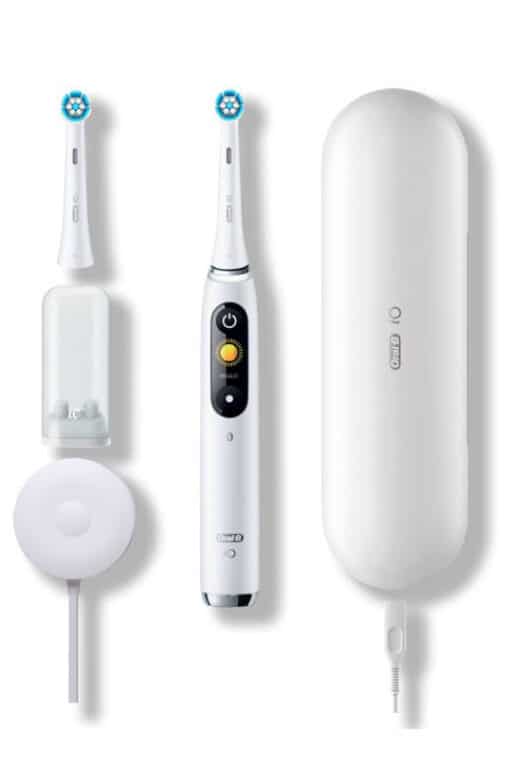
|

|
|---|---|
| Review | Review |
|
(5)
|
(4)
|
| $749 | $370 |
| $555 | $450 |
| Oscillating-rotating & micro-vibrations | Sonic |
| 7 | 4 |
| - | 3 |
|
|
|
| 30 second quadpacer | 20 second sextants |
|
|
|
| 14 days | 14 days |
| Rechargeable Lithium-Ion (Li-Ion) | Rechargeable Lithium-Ion (Li-Ion) |
| 2 | 2 |
|
|
|
|
|
|
|
|
- |
| 72dB | 71dB |
| 2 years | 2 years |
- 2 very different looking toothbrushes.
- The Oral-B iO has an interactive colour OLED display in the brush handle.
- The 2 brushes have different cleaning actions - sonic vs oscillating-rotating.
- The 2 brushes have different shaped brush heads.
- The DiamondClean will alert you via a light on the handle when it is time to change a brush head, based on tracked usage.
- The Oral-B iO has an LED light ring that can be lit a number of different colours.
- The iO has a visible pressure sensor that that 9000 does not.
- The iO is available in onyx black. The DiamondClean 9000 is available in black, white & pink.
- The iO has 7 cleaning modes (Daily Clean, Whitening, Gum Care, Sensitive, Intense, Super Sensitive & Tongue Clean) whilst the DiamondClean comes with 4 (Clean, White+, Deep Clean+ & Gum Health).
- The Sonicare DiamondClean 9000 offers 3 brushing intensity settings.
- The DiamondClean can automatically change the cleaning mode based on the brush head attached.
- The DiamondClean comes with 2 brush heads (1 x C3 Premium Plaque Control & 1 x W2 Optimal White) compared to the 2 x Ultimate Clean with the iO.
- The DiamondClean has the better battery life of up to 4+ weeks*.
- The iO gives more feedback from the battery than the DiamondClean.
- The DiamondClean has the better travel case with USB charging as opposed to a separate power adapter.
- The charging stands are different. The iO has a quick charge magnetic charging stand.
- The iO uses artificial intelligence technology to help track your brushing action & give 3D feedback to rate your overall clean better than the DiamondClean does.
- The DiamondClean pacer on 6 x 20 seconds intervals compared to the 4 x 30 seconds of the iO.
- The DiamondClean 9000 has automatic power off.
- The iO comes with a brush head storage unit
- Oral-B iO retail price higher than DiamondClean 9000.
Please note that there are a number of models within the iO range. Notably the 7 and 8 Series that are excluded from this comparison. It is the range topping 9 Series I am referring to and comparing here. It is the single handled variants of the iO and DiamondClean 9000 that are featured throughout this comparison.
Please note. Every effort is made to ensure the differences listed are correct. These are subject to change without notice. Products and box contents can change and different variants can exist.
Detailed comparison: what’s the difference between the Oral-B iO and Sonicare DiamondClean 9000?
Let me be clear from the outset. Both of these brushes achieve the same results, clean teeth.
Both brushes offer more than what anyone needs, but that isn’t a reason not to consider them.
Despite achieving the same end goal, there are quite a few differences between these 2.
The most obvious is the design and the way these brushes look.
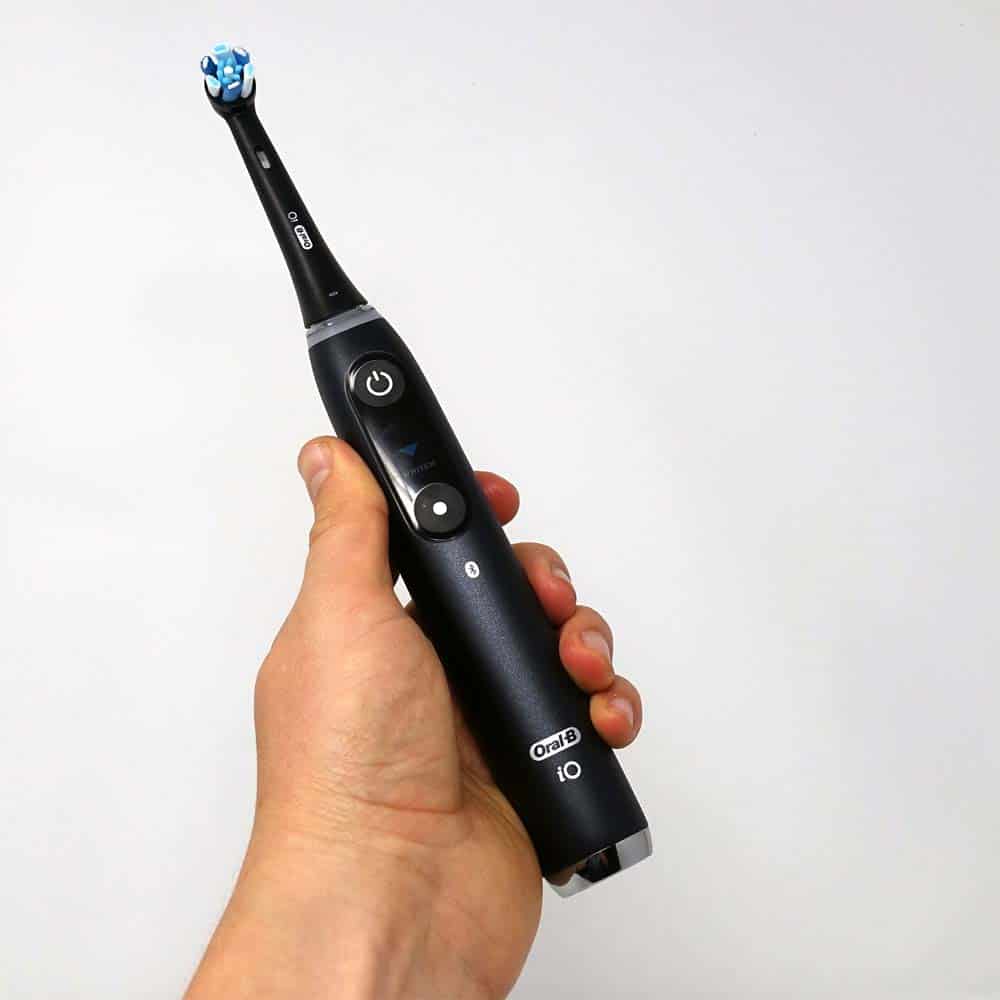
Oral-B have made massive strides with the iO, improving the materials, aesthetics and overall design language to better compete with Sonicare.
More closely matched than ever, the DiamondClean 9000 is, in my opinion at least, still the slightly more premium looking brush. It appears more refined and classy. This is most notable to the touch, it feels less plasticy!
Both handles are similarly shaped, although neither are perfect cylinders, they have that rounded design to the handles.
Both toothbrush handles feel solid in hand and I have little in the way of concern for the durability and reliability of these models.
The DiamondClean measurements are as follows:
- Height (without head) – 19.5cm
- Height (with head) – 25.5cm
- Width – 2.6cm
- Thickness – 3cm
- Weight (without head) – 136g
- Weight (with head) – 142g
The iO measurements are:
- Height (without head) - 18.5cm
- Height (with head) - 23.7cm
- Width - 2.8cm
- Thickness - 3cm
- Weight (without head) - 131g
- Weight (with head) - 139g
As you can see from the size and weight, there are not significant differences here.
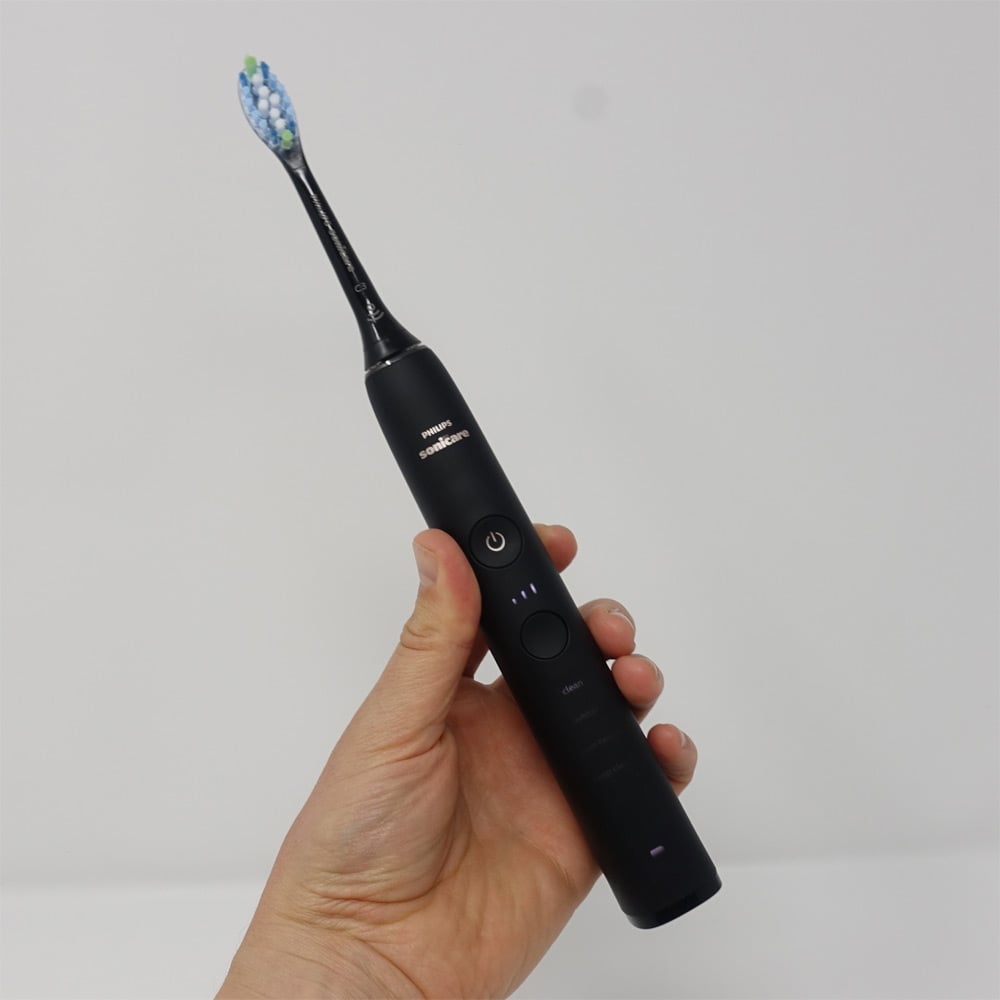
The images better depict the design differences than I can explain in text, so do take a close look at these.
Both have a separate power and mode button to power the brush on and change the cleaning modes.
The buttons on the iO are of the same concave design, but do have a rubber/silicone coating to them to make them a little more grippy compared to the DiamondClean.
Although they are almost invisible until they are backlit, the DiamondClean has the cleaning mode labels on the front of the handle below the lower mode button.
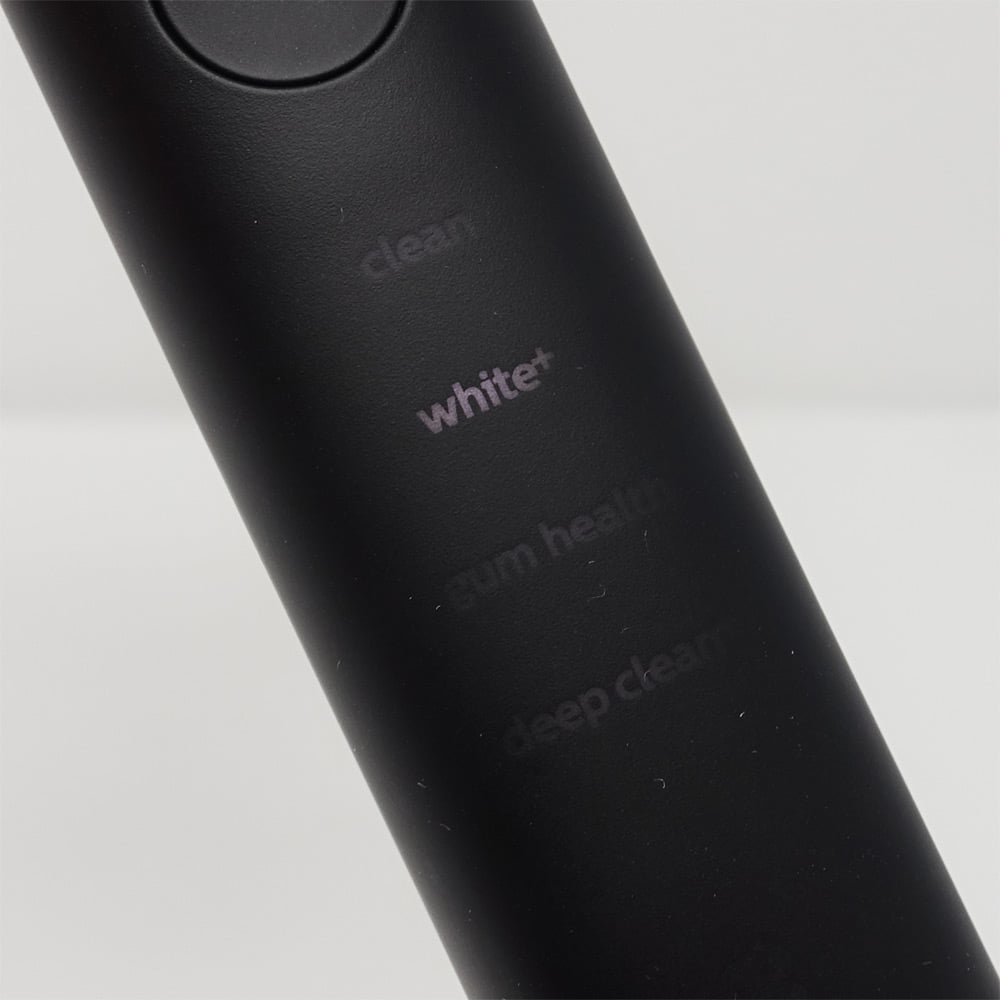
With the iO, all of the modes and other information is displayed on the OLED screen that is positioned between the 2 buttons. It is quite a different setup.
That screen is something that set’s these 2 brushes apart. It does not significantly alter your brushing experience, but it does offer some potentially beneficial elements to it. The most notable being the emoji style faces you get after you brush. Happy, sad or starry eyed faces give you a form of feedback not given by other products.
Then again, these are led more by brushing time than anything. If you have brushed for 30 seconds, you probably know that is not good enough compared to the recommended 2 minutes.
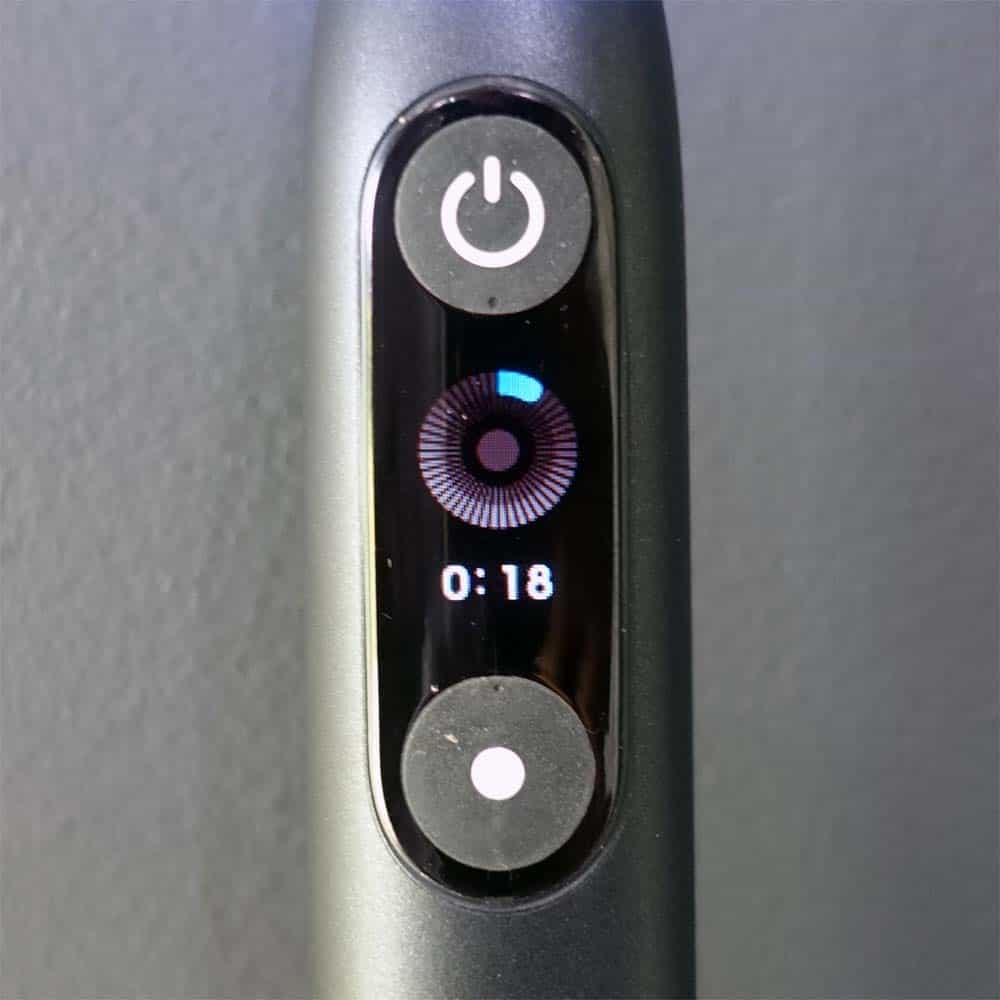
A fairly major aesthetic difference is the light ring and visible pressure sensor on the iO, compared to the Sonicare DiamondClean 9000.
Around the neck of the brush handle, just below the brush head is a translucent panel that runs a full 360 degrees around the handle.
Via the smartphone app or the handle itself, this can be programmed in different colours. But, it also turns green when you use the right amount of pressure and red when too much pressure is detected.
The DiamondClean 9000 has a pressure sensor, but it is not a visible sensor. Instead, when activated the brush handle vibrates until the pressure is relieved. The iO does not vibrate, so unless you actually look at the light ring and see it lit red, the pressure sensor is more noticeable on the 9000.
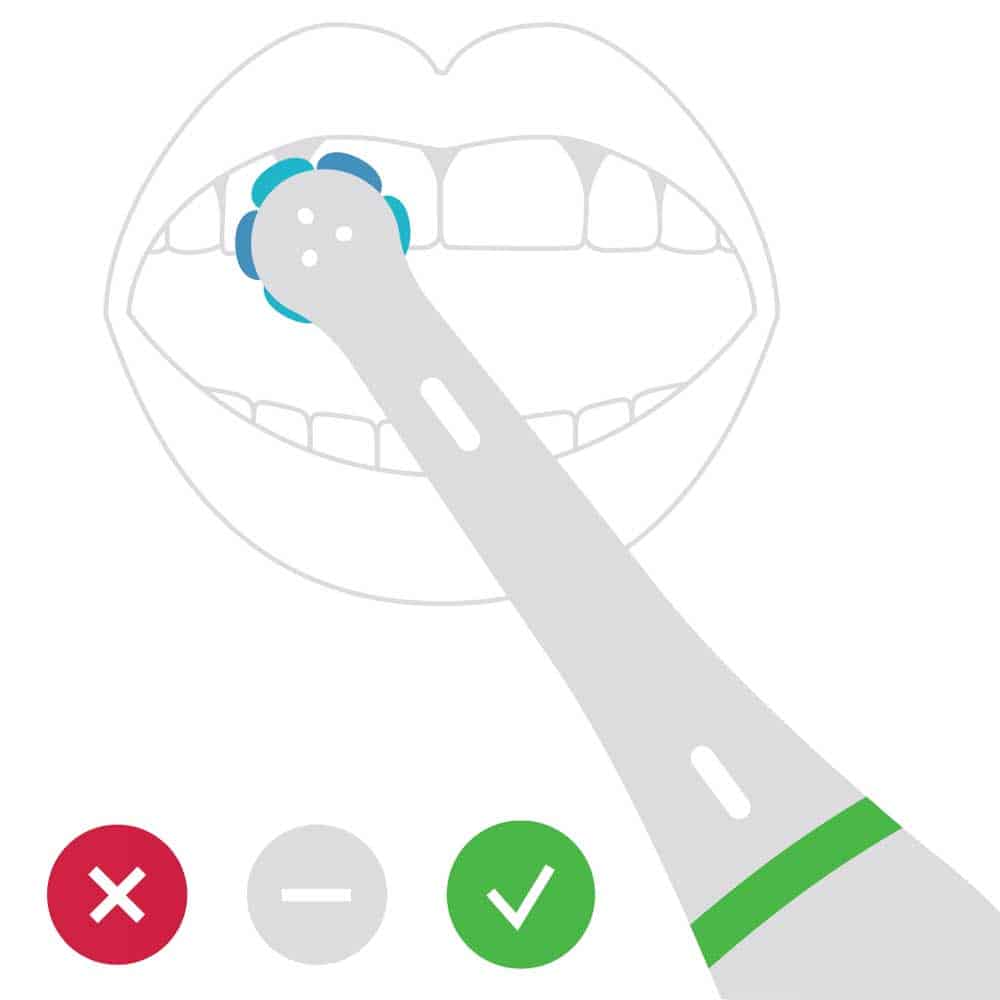
The handle colours do vary between the 2 models.
Sonicare offers the 9000 in black, white and pink whilst the iO is available in onyx black only.
Both Oral-B and Sonicare provide a black coloured brush head to match their black handles.
With the look of the handle covered, one of the biggest differentiators is their cleaning action.
Sonicare uses a sonic cleaning action whereas the Oral-B toothbrushes have an oscillating-rotating cleaning action.
The Sonicare brush heads are larger, sort of more ovalish shaped compared to the smaller, circular brush heads found on Oral-B.
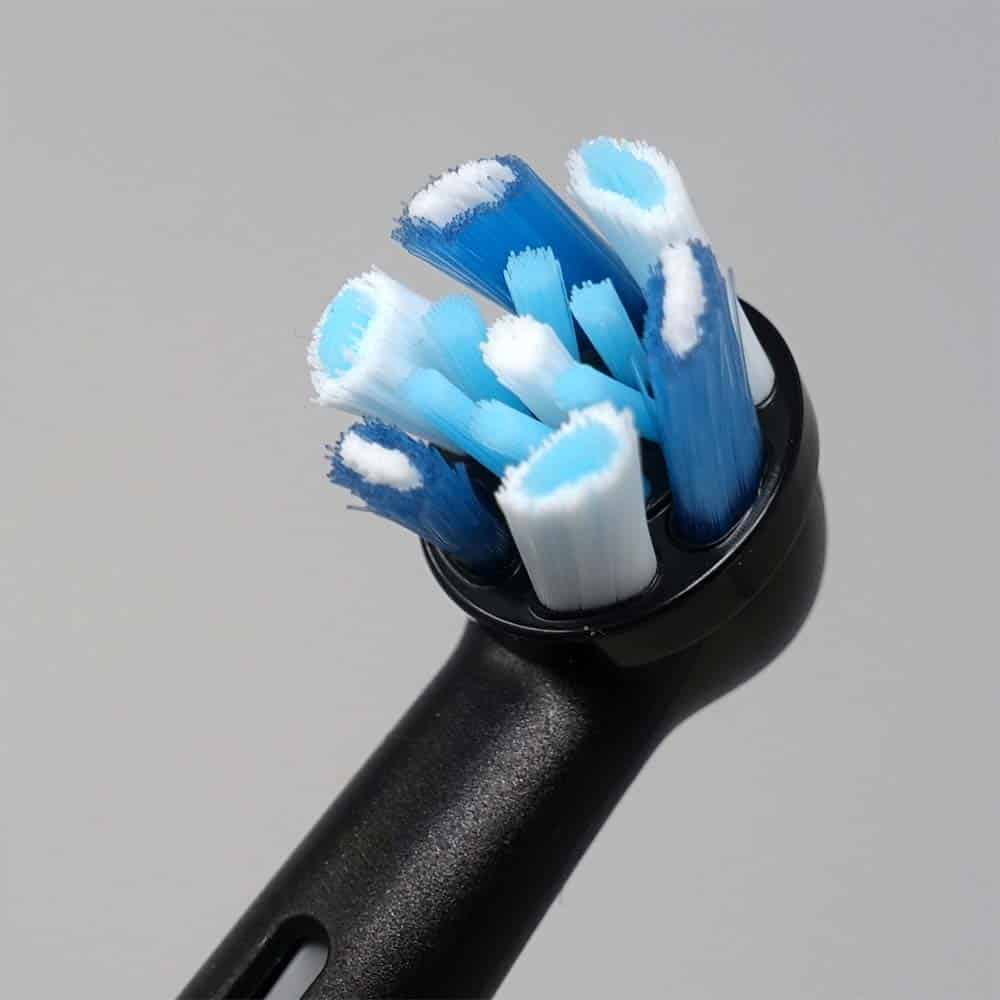
The sonic technology seen on Sonicare brushes uses 2 methods to clean the teeth. The first is a mechanical side-to-side cleaning motion of the brush and the second is a non-contact approach that uses the sonic technology that disrupts plaque beyond the tip of the bristles.
Oral-B’s cleaning is completed via an oscillating-rotating movement, and new for the iO is micro vibrations, another form of movement.
Oral-B brushes have a small, round brush head that moves back and forth (side to side movements) in a circular motion to help remove plaque and dental debris. The movement of the bristles and the head itself essentially scrub the teeth clean. You don’t need to repeatedly move the bush up and down, back and forth.
Micro vibrations offer an extra dimension to the clean. Essentially a ‘non-contact’ form of brushing and relies on pulsations/vibrations like Sonicare brushes do.
Whilst the cleaning action found on the Oral-B iO is more highly regarded clinically, both do a fantastic job. Whilst technically it is a fundamental difference between the 2, don’t get too worried about which approach is best.
The iO offers 7 cleaning modes as opposed to the 4 on the DiamondClean 9000.
The modes on each brush are as follows:
iO:
- Daily Clean
- Whitening
- Gum Care
- Sensitive
- Intense
- Super Sensitive (not available on Series 7)
- Tongue Clean (not available on Series 7 or 8)
DiamondClean 9000
- Clean
- White+
- Deep Clean+
- Gum Health
A bit like the cleaning action of the 2 brushes, don’t concentrate too much on the different modes.
The Sensitive modes that the iO offers is very similar to its own Gum Care mode. You could argue that the Gum Health mode on the Sonicare is equivalent to both of these.
The Tongue clean mode is also a shorter 30 second mode. A certain convenience it does bring, but you can still brush the tongue with any other mode or when the toothbrush is off. Or if you do use it with the brush on, just end the cleaning mode early.
There is too limited evidence that any of these modes actually deliver better results, compared to a single standard clean mode.
Linked to the cleaning modes is a brushing intensity option available on the DiamondClean 9000 that the Series 9 iO toothbrush does not have.
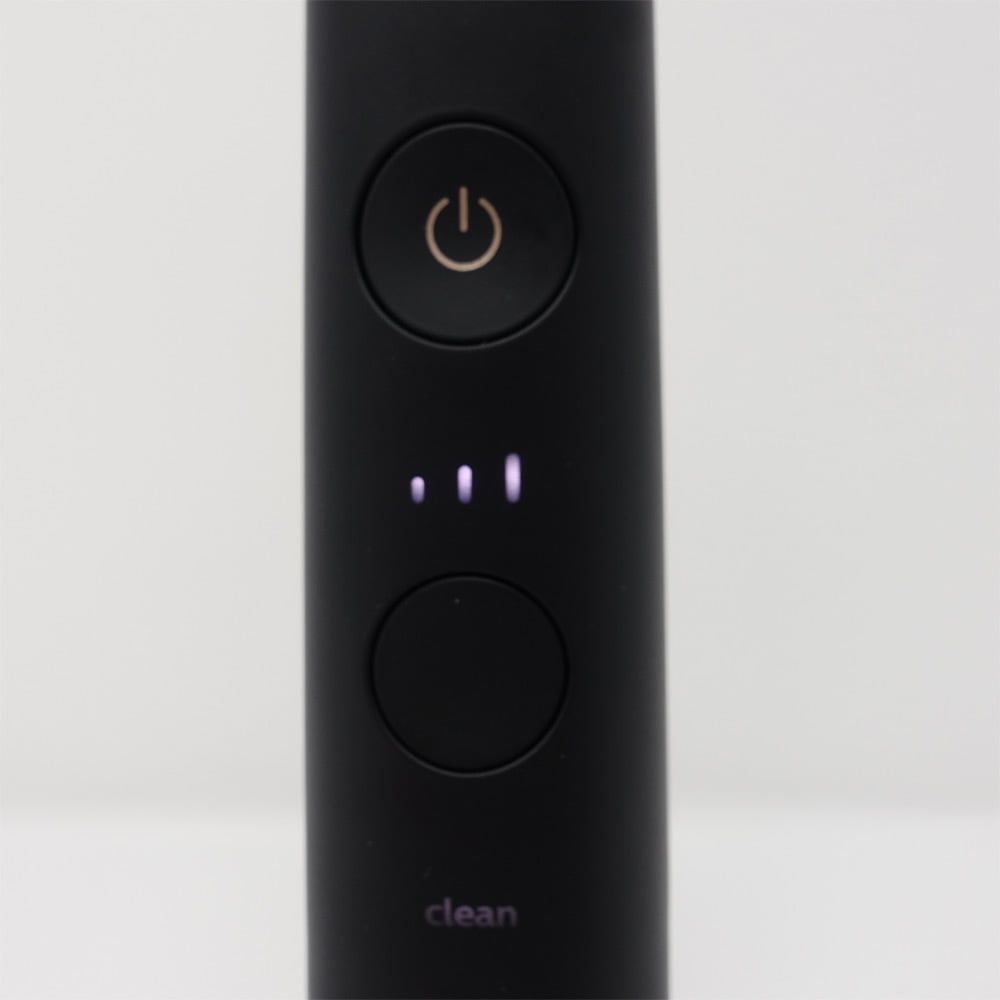
During any of the modes, you can press the cleaning mode button to change between low, medium and high intensity.
Essentially the power of the brushing mode is altered to be more gentle or more intense depending on your preference.
The brush does automatically select the best intensity, but you can override it.
This does then give you essentially 12 different cleaning configurations (4 cleaning modes x 3 intensities) compared to the 7 modes available with the iO.
The intensity selected is shown on the handle via 3 vertical light bars that are located between the power and cleaning mode button on the DiamondClean.
I have mentioned the brush heads briefly but these are quite a few extra things to be aware of.
Both Oral-B and Sonicare offer a range of heads which are interchangeable with their brush handle.
The DiamondClean 9000 comes with just 1 x C3 Premium Plaque Defence and 1 x W2 Optimal White brush head included in the box, whereas the iO comes with 2 x Ultimate Clean brush heads.
The Oral-B heads are smaller and can be more comfortable for some.
Either brush handle requires replacement heads during ownership and on average should be replaced every 3 months.
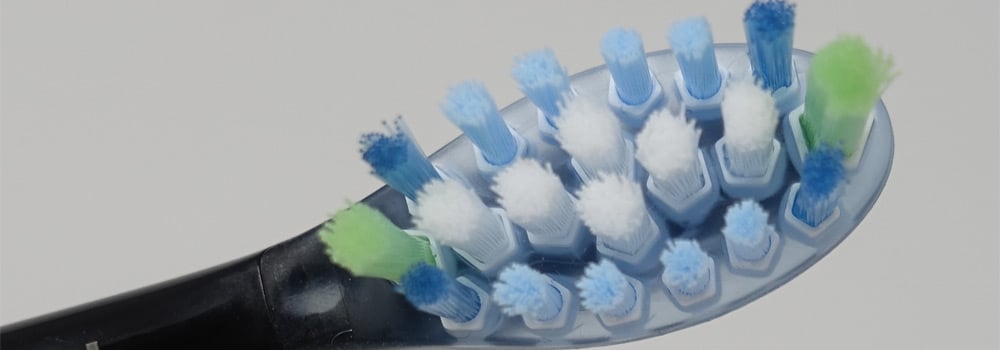
Whilst the Oral-B heads can be tracked within the smartphone app, the DiamondClean has a special bit of technology built-in.
Each brush head has an RFID chip inside, that is tracked by the handle. It is part of a technology Sonicare calls BrushSync.
It works in 2 ways.
The first is that the chip built into the brush head communicates with the handle to track how long it has been used for. Once used for 3 months, a light on the brush handle is lit orange/amber to alert you. This is incredibly clever and very useful for giving that visual reminder to change the brush head.
The second part is that depending on what brush head is fitted, the best-suited brushing mode is automatically selected. So, for example, fit the G2 Optimal Gum Care head and the Gum Health cleaning mode will be selected.
Whilst the Oral-B brush heads have fading indicator bristles and an in-app reminder, the iO, despite its clever technology and screen does not alert you via a light when the head needs replacing, nor does it change the brushing mode based on the head you attach.
With either brush, you can use any of the brush heads on any of the cleaning modes available on the toothbrushes.
The brush heads themselves fit only to the respective brands, but both are easy to replace, pulling off and the replacement pushing back on.
Whilst on the topic of heads, the iO comes with a brush head refill accessory in the box that holds up to 2 spare heads. The 9000 comes with no such accessory.
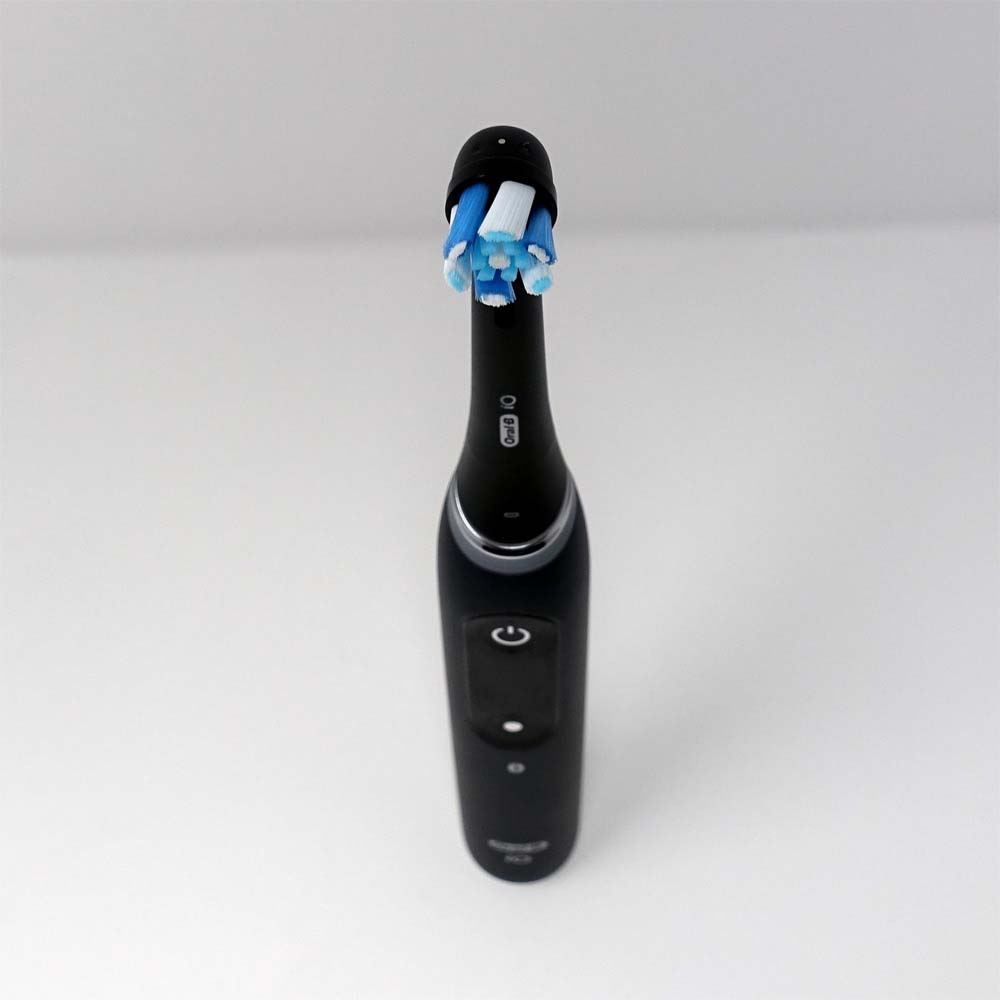
Both Oral-B and Sonicare have timers and pacers built into these brush handles. The idea is that these encourage you to brush the teeth evenly for the recommended amount of time.
However a subtle difference is that Oral-B has configured the iO, like all of its other brushes to 30 second intervals whereas the DiamondClean 9000 is configured to 20 seconds.
A point to note is that this pacer is disabled with the iO when used at the same time as the app.
In any typical 2 minute cleaning cycle you have 4 x 30 second periods or 6 x 20 seconds.
So, the areas you brush under 30 second pacing looks like:
- Upper right
- Upper left
- Lower right
- Lower left
When brushing at 20 second pacing:
- Upper right back teeth
- Upper front teeth
- Upper left back teeth
- Lower left back teeth
- Lower front teeth
- Lower right back teeth
At the end of the 20 or 30 second sections, the brush motors pause briefly changing the sound of the brush and the brushing sensation, this is your cue to move to the next section.
At the end of the cleaning cycle the same thing happens, but the DiamondClean 9000 has an automatic power off feature, which makes it very clear the cleaning cycle is complete. The iO Series 9 continues to function, relying on you to turn the brush off. Well technically, it will auto power off after 5 minutes, but you don’t need to brush for this length of time.
Built into both brushes are rechargeable lithium-ion batteries each claiming a battery life of 2 weeks.
In my testing the DiamondClean lasted an extra 2+ weeks over the iO, achieving up to 4+ weeks of usage time compared to the 14 days of the iO.
They do report the battery information a little differently, the iO doing a better job thanks to the display.
At the end of each cleaning cycle, it shows the remaining power on the screen as an icon with a percentage (%) stated. It is set to 10% increments.
The DiamondClean on the other hand just has an icon at the bottom of the handle which only gives real feedback when at approx 10% or below.
Oddly, despite the iO being a smart toothbrush, the app does not report any battery status, yet the DiamondClean does. What is displayed is not a helpful percentage (%), instead, the words high, good and low, but it is better than nothing.
Both models will, of course, need charging at some point and both come with 2 options to charge the toothbrush. Both have a charging stand that the brush sits on to be charged and both come with a travel case that allows the brush to be recharged whilst inside the case.
The iO comes with what initially looks like a more traditional charging stand. A circular stand, it has a slight protuberance on the top that aligns with the slight recess in the base of the handle.
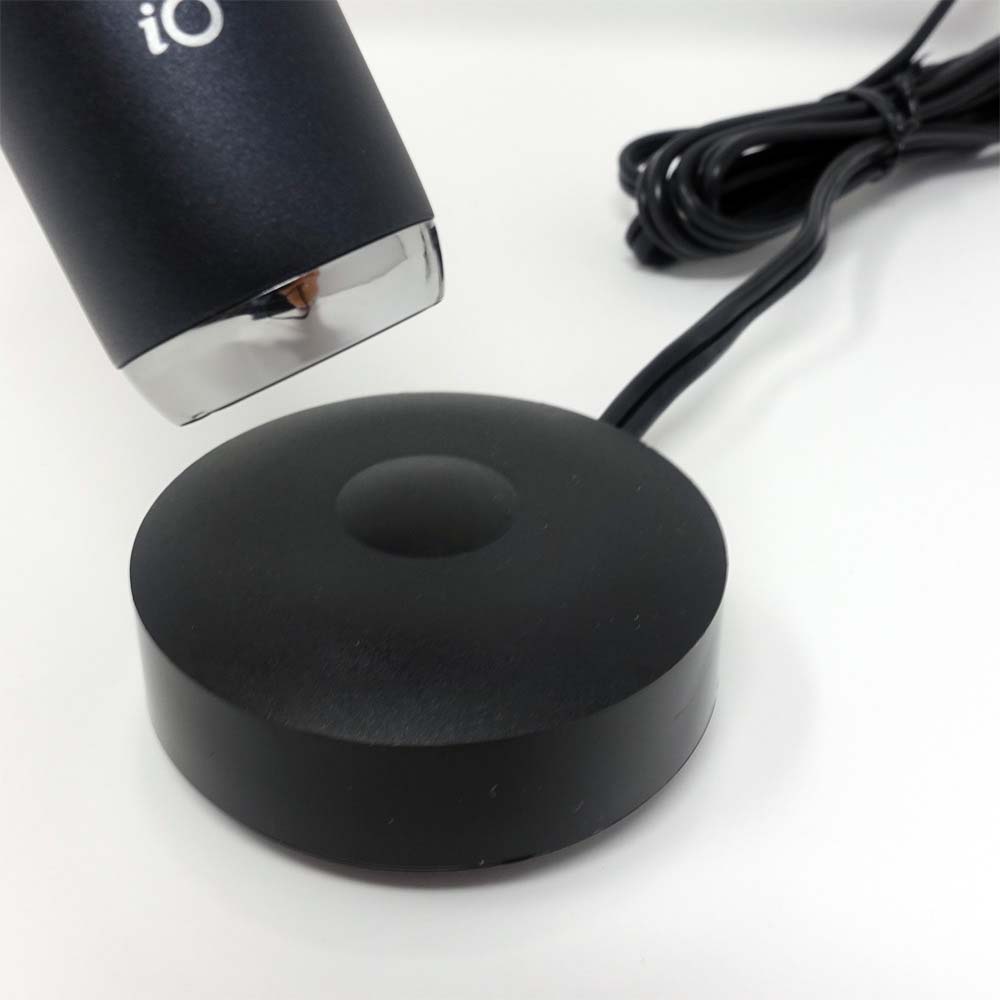
This stand is in fact magnetic and holds the brush upright. It actually charges the iO rapidly, in just 3 hours.
The DiamondClean on the other hand comes with a stand made up of 2 parts. There is a charging base plate onto which fits a clear plastic frame, that the handle then sits within. It functions in basically the same way. I think it looks more premium from a distance. But, in reality, the iO solution is better. It can take up to 24 hours to charge the DiamondClean, although it appeared to be fully charged most of the time in just 12 hours in my testing.
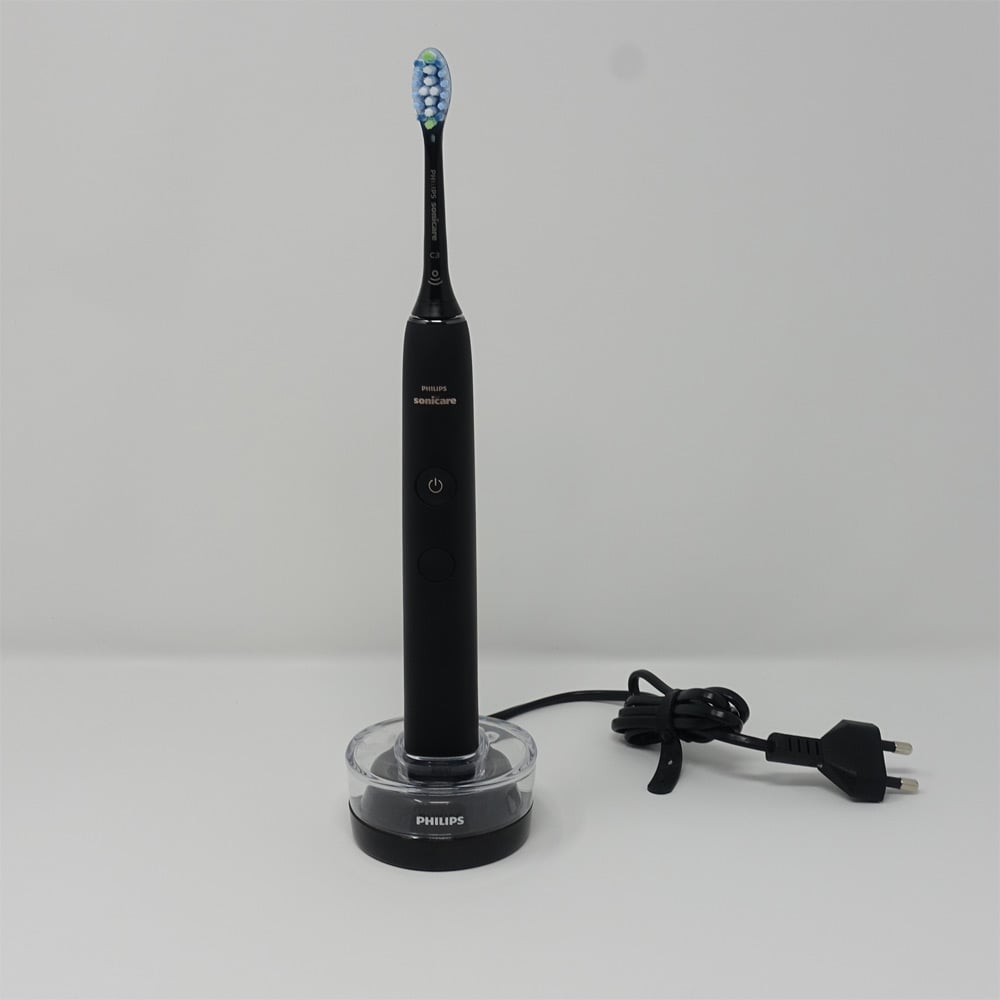
Both charging stands have a 2 AU pin power connector that connects to a power outlet and both support 100-240v.
With these brushes you get a travel case that allows the brush to be charged inside.
The DiamondClean configuration looks smarter and is more practical.
It holds the handle and up to 2 brush heads.
Hardwired into the base is the charging cable that can be accessed and unwound to offer a USB connector that can be plugged into a mains socket, power adapter or computer’s USB connection.
The iO’s power2go case on the other hand, has a separate proprietary charger that supports 100-240v and connects to a 2 pin socket.
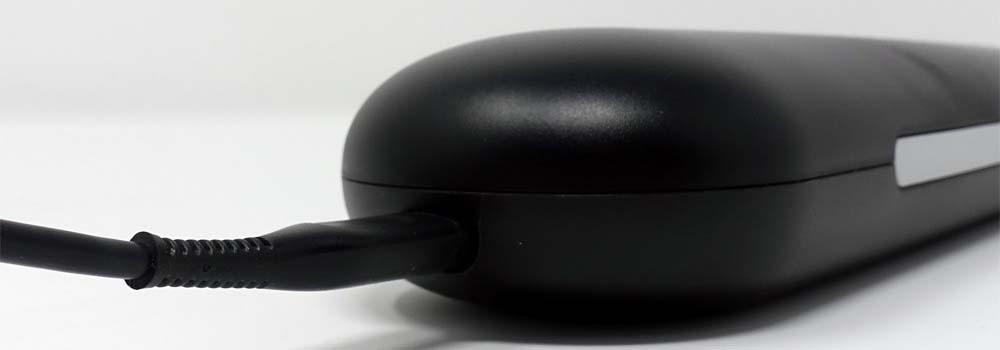
The downside is this large power adapter that must be carried and the case must be connected to mains power to charge the brush and connected USB device.
The case feels cheaper too, being all plastic construction. There is no soft touch leather effect top like there is on the lid of the DiamondClean’s case.
You can too only hold 1 brush handle and head, rather than the more typical 2 heads.
Simply put, the Sonicare option is more refined and practical.
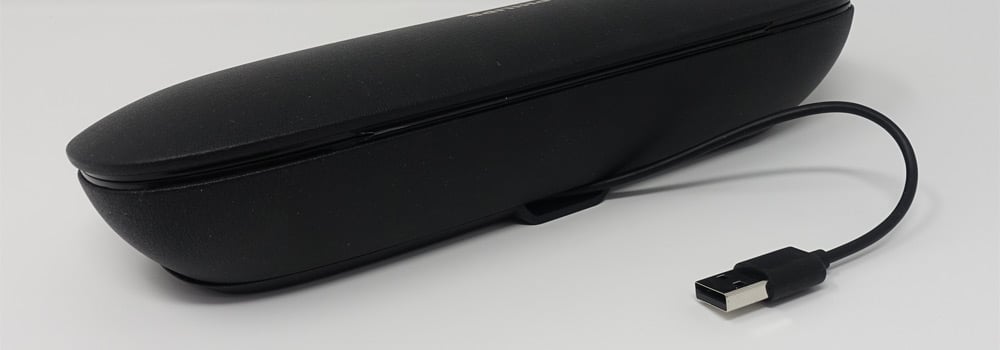
Now a key selling point for both brushes is the fact that they are smart. But the implementation is a bit different.
Both brushes use Bluetooth to connect the handle and the smartphone. Both companies offer Android and iOS apps for free.
Both apps are designed to take data collected by sensors in the brush handle and interpret it so that you can take insight and learn from it to be able to clean your teeth better.
The DiamondClean is primarily configured to sync the data with the app after the cleaning session.
This data is then charted in a fairly simplistic way to make it very clear and easy to understand.
The use of 3 colours does make it possible at a glance to achieve key learnings. However, the data is only synced for 7 days and you don’t get the historic data you would likely want to see improvements over extended periods.
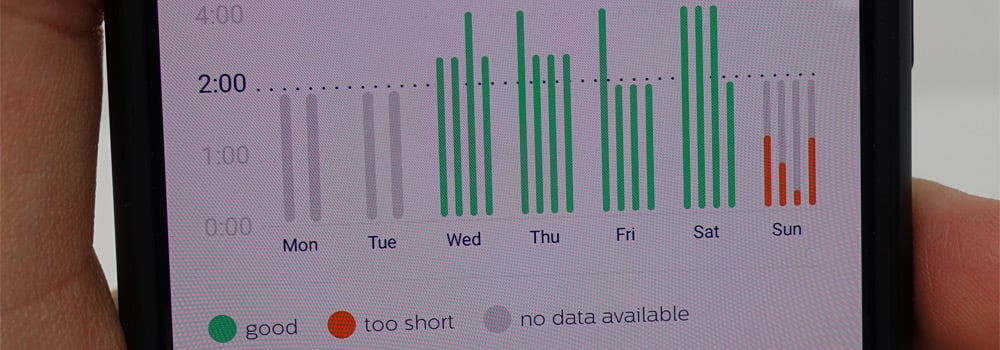
The Oral-B configuration for the iO is quite different. Considerably more comprehensive. This is in part because it is configured to work best in real-time.
The idea is you use the app at the same time that you brush, although some data will sync after the brushing session if you don’t wish to use your phone at the same time as you brush.
Oral-B suggests the iO uses artificial intelligence (AI) as part of its process to monitor brushing and to give the feedback, it all sounds very impressive. What this really means is that
Oral-B’s app provides on screen graphics that show the teeth you have and have not cleaned. The teeth on the graphic turn white when you have brushed them properly. It is giving feedback as you brush so you can perfect the cleaning there and then.
The DiamondClean 9000 does transfer some data in real-time if you want it. This includes the elapsed brushing time and pressure detection, it does not track the exact position of the brush in the mouth like the iO does.
So what this means is that the Oral-B iO would know if you had not brushed all of the top teeth for example, because the graphic would not be complete. Whereas the Sonicare 9000 has no way of showing or determining this as it is not tracking the brush handle location in the mouth.
In both instances the aim is for us to achieve better oral health care at home.
Lastly, both models come with a 2 year warranty as standard, but go online and register the iO and you have the option of extending this to 3 years (for free).
Does one clean better than the other?
The short answer is no.
The longer and more complicated answer is yes, the iO could potentially clean the teeth better.
The reality is that actually positively saying 1 brush cleans better than the other is very difficult.
There are many variables and only if tested as part of a thorough and well managed clinical trial could conclusive evidence be gained to confirm, which, if either actually brushed better.
There are very valid arguments that the Oral-B iO is able to clean the teeth better.
The most convincing argument is that an independent study by Cochrane suggests that there is evidence that Oral-B is more effective.
It was however quite clearly stated whilst evidence favoured Oral-B the differences are small and clinically unclear with further studies required.
So, realistically don’t worry about this too much. Both will clean the teeth really well if used correctly.
One thing to add here though is that the features, primarily those available in the iO, might encourage and help you become better at brushing your teeth. Therefore indirectly returning better results, not from the toothbrush directly, but because you form better habits.
Both models are smart toothbrushes that provide feedback but the iO goes to greater lengths and provides that real-time data in a way the DiamondClean does not.
The Oral-B app is more comprehensive.
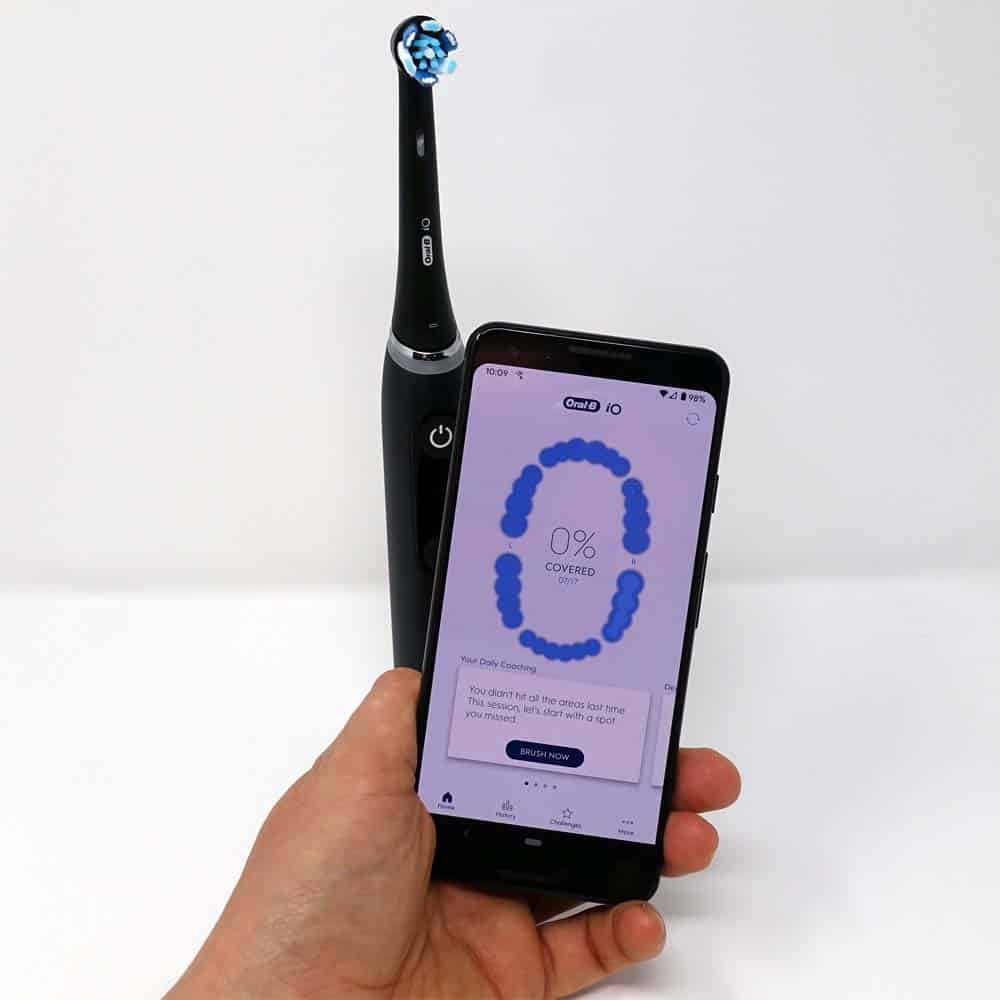
With real-time data, on screen it shows you which teeth you have and have not cleaned very well. This can be a real advantage in ultimately brushing your teeth to a higher standard over the long term as the graphics make it really clear how and where you can improve.
Sonicare displays similar data, but differently within their app. It is not as comprehensive and it certainly does not show in real-time or post brushing which areas of the mouth you have or have not brushed.
Add in the display built into the toothbrush handle of the iO and you have that extra dimension of feedback via the on-screen emojis, even if you are not using the app. This is something that you would not get with the DiamondClean.
If such data and graphics will get you engaged and encouraged to brush then fantastic, the iO could carve out a lead for you.
Is one priced better than the other?
Yes and no. Sorry, perhaps not the simple answer you wanted.
If we take the recommended retail price alone then the answer is yes.
The DiamondClean 9000 is $370 compared to the $749 of the Oral-B iO Series 9.
A $380 premium is a ridiculous premium. You could buy about 3 or 4 perfectly good electric toothbrushes for this price difference alone.
Based on retail prices, the DiamondClean is the better buy.
However, I don’t ever suggest you buy either of these prices.
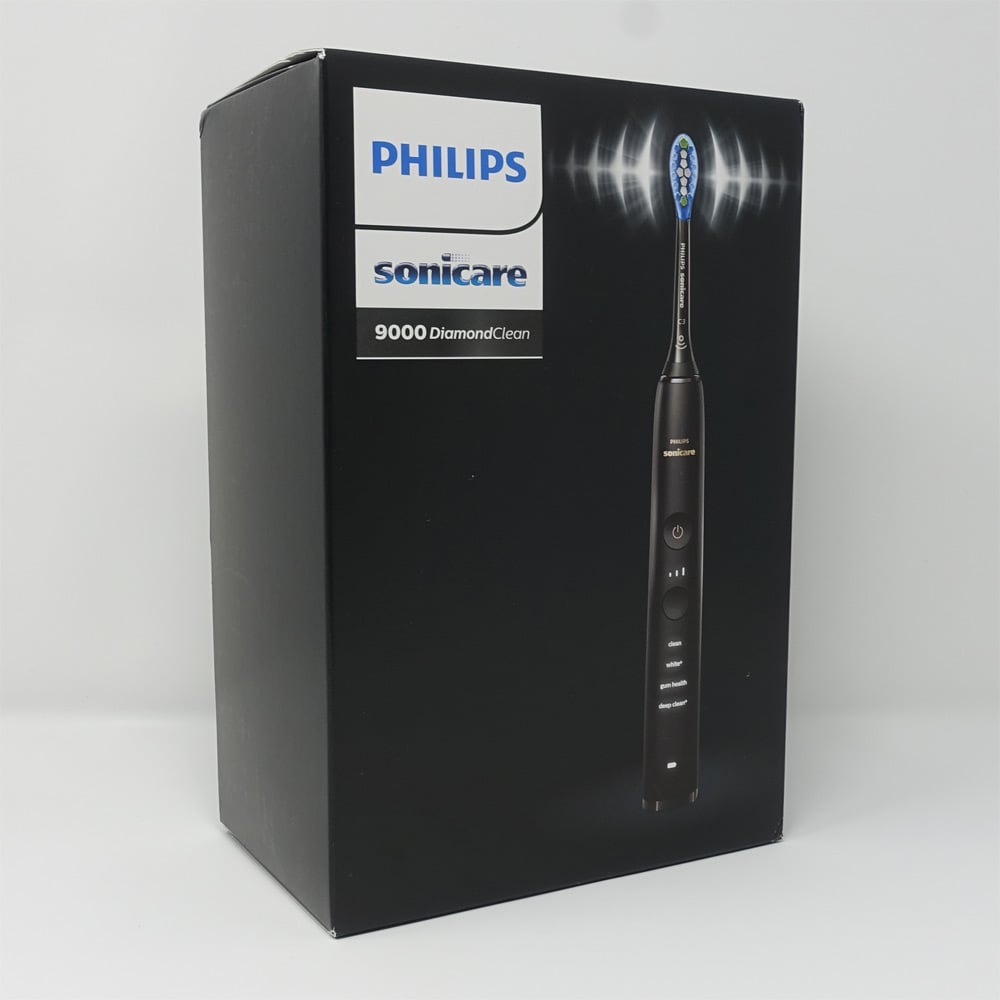
The reality of the situation is that these prices are artificially high so that they can be discounted to a still high, but perhaps more justifiable amount.
Prices and discounts are always subject to change, but Oral-B brushes tend to be discounted by 50%, thus bringing the iO to a still eye watering $375.
At times the discount is even greater and I would not be at all surprised to see the iO hitting around $350 from time to time.
Sonicare brushes do get discounted, but the range is anywhere between 20-50% on average. The 9000 to date hasn't seen quite such significant discounts.
You can pick it up for somewhere around $330.
With these recalculated figures, the difference is typically going to be around $20-45, the DiamondClean being the cheaper.
Sometimes it might be more or less. Sometimes the iO might be the cheapest.
To get a real ideal of value, working out an ownership cost over an extended period of time is useful. Brush heads can have a reasonable bearing on the overall cost.
The DiamondClean 9000 over 3 years will work out at apprioximately $0.41 per day to own.
The iO on the other hand comes in at $0.46 per day on average or whopping $0.87 a day if you paid full price!
The list of differences between these models is pretty reasonable, but putting a value on those can be tricky.
If you particularly want smart features, and I suspect you will at this price point, the iO is significantly better and definitely justifies a premium. A $50 premium?! I think so, just about, if you are invested in really understanding and improving your oral health.
It is your decision really. Pay a p
Please note that all prices quoted are approximates and should be used only as a guide during your decision process.
Conclusion
Both the iO and the DiamondClean 9000 are premium toothbrushes that offer more than what the vast majority of us need.
They too command a price that most won’t be able to justify.
You do not need to spend several hundred pounds on an electric toothbrush. $80-100 will get you a perfectly functional brush.
But, if you want to own one of the best products on the market today and benefit from the refinements and extras these bring, it is the iO from Oral-B that is the brush to go for.
The travel case and brush head replacement reminder system are better implemented on the Sonicare, but as a complete package the iO is the brush you want to be using to improve your oral health.
*A previous version of this comparison suggested the iO had a superior battery life of 6+ weeks compared to the 4+ of the DiamondClean 9000.
As part of our testing process, it is necessary to simulate battery use for consistency. We do this by charging the brush fully and running the toothbrush through brushing cycles until it discharges completely.
The iO continues to offer a battery life of 6+ weeks in these tests. However, repeated in hand testing has shown the battery life to only be 2 weeks. This is a discrepancy we have never previously experienced. All other brushes have to date performed almost identically during in hand test to those simulated.



